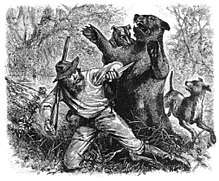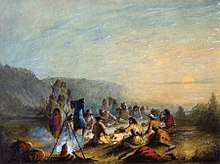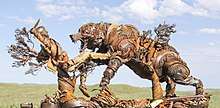Hugh Glass
Hugh Glass (c. 1783 – 1833)[1][2][3] was an American frontiersman, fur trapper, trader, hunter, and explorer. He is best known for his story of survival and forgiveness after being left for dead by companions when he was mauled by a grizzly bear.
Hugh Glass | |
|---|---|
 A picture depicting Glass being attacked by a bear, from an early newspaper illustration of unknown origin | |
| Born | c. 1783 Scranton, Pennsylvania, U.S. |
| Died | 1833 (aged c. 50) |
| Other names | Old Hugh, Old Rinoe, Old Glass |
| Occupation | Frontiersman, trapper, fur trader, hunter, explorer |
| Employer | Rocky Mountain Fur Company, Jean Lafitte, self-employed |
| Known for | Surviving a grizzly bear attack |
| Spouse(s) | Unknown |
Born in Pennsylvania to Scots-Irish parents, Glass became an explorer of the watershed of the Upper Missouri River, in present-day Montana, the Dakotas, and the Platte River area of Nebraska.[4] His life story has been the basis of two feature-length films: Man in the Wilderness (1971) and The Revenant (2015). They both portray the survival struggle of Glass, who (in the best historical accounts) crawled and stumbled 200 miles (320 km) to Fort Kiowa, South Dakota, after being abandoned without supplies or weapons by fellow explorers and fur traders during General Ashley's expedition of 1823. Another version of the story was told in an episode of Death Valley Days titled "Hugh Glass Meets a Bear", with a release date of March 24, 1966.
Despite the story's popularity, its accuracy has been disputed. It was first recorded in 1825 in The Port Folio, a Philadelphia literary journal, as a literary piece and later picked up by various newspapers. Although originally published anonymously, it was later revealed to be the work of James Hall, brother of The Port Folio's editor. There is no writing from Hugh Glass himself to corroborate the veracity of it. Also, it is likely to have been embellished over the years as a legend.[5][6]
Early life
Glass was born in Pennsylvania, to Scots-Irish parents.[4] His life before the famous bear attack is largely unverifiable, and his frontier story contained numerous embellishments. He was reported to have been captured by pirates under the command of Gulf of Mexico chief Jean Lafitte off the coast of Texas in 1816, and was forced to become a pirate for up to two years.[7] Glass allegedly escaped by swimming to shore near what is present-day Galveston, Texas. He was later rumored to have been captured by the Pawnee tribe, with whom he lived for several years. Glass traveled to St. Louis, Missouri in 1821, accompanying several Pawnee delegates invited to meet with U.S. authorities.[8]
General Ashley's 1823 expedition

In 1822, many men responded to an advertisement in the Missouri Gazette and Public Advertiser placed by General William Henry Ashley,[9] which called for a corps of 100 men to "ascend the river Missouri" as part of a fur-trading venture. Many of them, who later earned reputations as famous mountain men, also joined the enterprise, including James Beckwourth, John S. Fitzgerald, David Jackson, William Sublette, Jim Bridger, Thomas Fitzpatrick, and Jedediah Smith. These men and others would later be known as "Ashley's Hundred". Glass, however, did not join Ashley's company until the next year, when he ascended the Missouri River with Ashley. In June 1823 they met up with many of the men that had joined in 1822, and were attacked by Arikara warriors. Glass was apparently shot in the leg and the survivors retreated downstream and sent for help.[10]
Glass wrote a letter to the parents of John S. Gardner, killed on June 2, 1823:[11]
Dr Sir:
My painful duty it is to tell you of the death of your son who befell at the hands of the Indians 2nd June in the early morning. He died a little while after he was shot and asked me to inform you of his sad fate. We brought him to the ship when he soon died.
Mr. Smith a young man of our company made a powerful prayer who moved us all greatly and I am persuaded John died in peace. His body we buried with others near this camp and marked the grave with a log. His things we will send to you.
The savages are greatly treacherous. We traded with them as friends but after a great storm of rain and thunder they came at us before light and many were hurt. I myself was shot in the leg. Master Ashley is bound to stay in these parts till the traitors are rightly punished.
Yr Obt Svt Hugh Glass
Grizzly bear mauling

.jpg)
Glass and the rest of the Ashley Party eventually returned to Fort Kiowa to regroup for the trip west. Andrew Henry, Ashley's partner, had joined the group, and he along with Glass and several others set out overland to the Yellowstone River. Near the forks of the Grand River, near present-day Shadehill Reservoir, Perkins County, South Dakota, while scouting for game for the expedition larder, Glass surprised and disturbed a grizzly bear with two cubs. The bear charged, picked him up, bit and lacerated his flesh, severely wounded him, and forced him to the ground. Glass nevertheless managed to kill the bear with help from his trapping party, but was left badly mauled. The men were convinced Glass would not survive his injuries; nevertheless, they carried Glass on a litter for two days, but doing so greatly slowed the pace of the group's travel.[12]
Henry asked for two volunteers to stay with Glass until he died and then bury him. John S. Fitzgerald (not to be confused with Thomas Fitzpatrick, who had separated from the Henry party with Jedediah Smith to find an overland trail to the Green River country) and a man later identified as "Bridges" stepped forward, and as the rest of the party moved on, began digging his grave.[13][14] Later, claiming that they were interrupted by attacking Arikara, the pair grabbed the rifle, knife, and other equipment belonging to Glass and took flight. Fitzgerald and "Bridges" later caught up with the party and incorrectly reported to Ashley that Glass had died. There is a debate whether Bridges was actually famed mountain man Jim Bridger.[15]
Despite his injuries Glass regained consciousness, but found himself abandoned without weapons or equipment. He had festering wounds, a broken leg, and deep cuts on his back that exposed his bare ribs. Glass lay mutilated and alone, more than 200 miles (320 km) from the nearest American settlement at Fort Kiowa, on the Missouri River. Glass set the bone of his own leg, wrapped himself in the bear hide his companions had placed over him as a shroud, and began crawling back to Fort Kiowa. To prevent gangrene, Glass allowed maggots to eat the dead infected flesh in his wounds.
Using Thunder Butte as a navigational landmark, Glass crawled overland south toward the Cheyenne River where he fashioned a crude raft and floated downstream to Fort Kiowa. The journey took him six weeks. He survived mostly on wild berries and roots.
Pursuit of Fitzgerald and Bridges
After recovering from his wounds, Glass set out again to find Fitzgerald and "Bridges". He eventually traveled to Fort Henry on the Yellowstone River but found it deserted. A note indicated that Andrew Henry and company had relocated to a new camp at the mouth of the Bighorn River. Arriving there, Glass found "Bridges", but apparently forgave him because of his youth, and then re-enlisted with Ashley's company.[8]
Glass later learned that Fitzgerald had joined the army and was stationed at Fort Atkinson in present-day Nebraska. Glass reportedly spared Fitzgerald's life because he would be killed by the army captain for killing a soldier of the United States Army. However, the captain asked Fitzgerald to return the stolen rifle to Glass, and before departing Glass warned Fitzgerald never to leave the army, or he would still kill him.[8] According to Yount's story, Glass also obtained $300 as compensation.[8]
Further explorations for General Ashley in 1824
In the period intervening, between finding "Bridges" and finding Fitzgerald, Glass and four others were dispatched in February 1824 with mail for Fort Atkinson. They traveled up the Powder River, then across to the Platte River. There they constructed skin boats and traveled down the Platte River to the lower end of the Black Hills.[16] Glass and his party discovered a settlement of 38 lodges of Arikara. Their leader, who was known by Glass, declared the tribe to be friendly and invited them in so the men went ashore. While smoking with him in his lodge, Glass noticed their equipment being taken by the residents and realized it was a trap.[16] The men quickly fled but two were killed by the pursuing war party. Glass managed to hide behind some rocks until the Arikara gave up their search, but was separated from the two other survivors. He was relieved to find his knife and flint in his shot pouch and traveled to Fort Kiowa, surviving off the land.[16]
Glass returned to the frontier as a trapper and fur trader. He was later employed as a hunter for the U.S. Army garrison at Fort Union, near Williston, North Dakota.
Death
Glass was killed along with two of his fellow trappers in early spring of 1833 on the Yellowstone River in an attack by the Arikara.[17]
A monument to Glass now stands near the site of his mauling on the southern shore of the present-day Shadehill Reservoir in Perkins County, South Dakota, at the forks of the Grand River. Nearby, the Hugh Glass Lakeside Use Area is a free state-managed campground and picnic area.
In the media
Glass' life has been recounted in numerous books and dramas.

- "The Song of Hugh Glass" (1915) is the second part of the sequence of epic poems, Cycle of the West, by John G. Neihardt.
- Western writer Frederick Manfred penned Lord Grizzly (1954), an account of Glass' ordeal nominated for a National Book Award.
- In the 1966 episode "Hugh Glass Meets the Bear" of the syndicated television series, Death Valley Days, the British actor John Alderson played the part of Glass. Morgan Woodward was cast as trapper Thomas Fitzpatrick, Victor French as Louis Baptiste, and Tris Coffin as Major Andrew Henry.[18]
- The film Man in the Wilderness (1971) is loosely based on Glass. It stars Richard Harris as Zachary Bass and John Huston as Captain Henry.
- Dewitt Lee played Sam Glass in a film called Apache Blood (1975), a story loosely based on that of Glass.
- Author John Myers Myers wrote The Saga of Hugh Glass: Pirate, Pawnee, and Mountain Man, a historical account published by the University of Nebraska Press in 1976.
- Roger Zelazny and Gerald Hausman meshed the stories of John Colter and Glass in the 1994 novel Wilderness.
- Hugh Glass, Jim Bridger and Tom Fitzpatrick appear in The Wandering Hill: Volume 2 of the Berrybender Narratives by Larry McMurtry (New York, Simon & Schuster, 2003). The novel begins with the return of Glass from his bear mauling and his attempt to settle the score with Fitzpatrick and Bridger.
- The song "Six Weeks" by Of Monsters and Men is "inspired by the true tale of American frontiersman Hugh Glass, seemingly left for dead after killing a bear that attacked him."[19]
- Michael Punke's 2002 novel, The Revenant, is a fictional retelling of Glass's encounter with the bear and search for revenge.
- A 2014 episode of podcast The Dollop features Glass as its main subject of discussion.[20]
- The May 27, 2015, episode of the History Channel's Monument Guys, "Tesla and the Unbreakable Glass," features the construction of sculpture of Glass and a bear.[21]
- Sculptor John Lopez unveils a life-size welded sculpture of Hugh Glass being attacked by a Grizzly at the inaugural "Hugh Glass Rendezvous" held on the site that the actual mauling took place in 1823. The sculpture is permanently on display at the Grand River Museum in Lemmon, SD.[22]
- Leonardo DiCaprio played a largely fictionalized version of Glass in the 2015 film The Revenant, directed by Alejandro González Iñárritu.[23] The film is based in part on Punke's novel and was met with critical acclaim. It earned 12 Academy Award nominations and won three. For his portrayal of Glass, DiCaprio won the Academy Award for Best Actor.
- Hugh Glass appears in World of Warcraft as a deranged merchant in Grizzly Hills alongside his "pet" bear Griselda.[24]
References
- Keys, Jim. "Hugh Glass: Mountain Man". The History Herald. Retrieved January 23, 2016.
- "Hugh Glass, mountain man: 'Revenant' tale intertwines with Montana history". The Montana Standard. Retrieved January 23, 2016.
- "Biographical Notes: Hugh Glass". Wandering Lizard California. Archived from the original on May 8, 2006. Retrieved January 23, 2016.
- "Hugh Glass: Mountain Man | Civil War, American Indian Wars, Pioneers (1801-1900) | American History | Articles". www.thehistoryherald.com.
- "Best served cold: the terrifying true story behind The Revenant". The Telegraph. Retrieved March 1, 2016.
- Todd, Edgeley W (Winter 1955). "James Hall and the Hugh Glass Legend". American Quarterly. The Johns Hopkins University Press. 7 (4): 362–370. JSTOR 2710430.
- "Hugh Glass – Fact vs Fiction". The Real Story of Hugh Glass. Retrieved January 5, 2016.
- "Biographical Notes – Hugh Glass". Wandering Lizard History. Archived from the original on May 8, 2006. Retrieved October 4, 2015.
- "Want Ads for Mountain Men". www.mtmen.org.
- "Timeline - The Real Story of Hugh Glass".
- "Letter" (PDF). history.sd.gov. Retrieved February 23, 2020.
- "Grizzly Attack - The Real Story of Hugh Glass".
- Thrapp, Dan L. (August 1, 1991). Encyclopedia of Frontier Biography: G-O. U of Nebraska Press. ISBN 0803294190.
- Monumental Mysteries
- "Did Jim Bridger Abandon Hugh Glass". Hugh Glass – The Real Story. Museum of the Mountain Man. Retrieved December 18, 2015.
- Dennie, Joseph; Hall, John Elihu (January 1, 1825). "The Port Folio". Harrison Hall.
- "Hugh Glass Later Life". Hugh Glass – The Real Story. Museum of the Mountain Man. Retrieved December 18, 2015.
- "Hugh Glass Meets the Bear on Death Valley Days". Internet Movie Data Base. March 24, 1966. Retrieved September 9, 2015.
- Hilmarsdóttir, Nanna Bryndís. "Of Monsters and Men Biography". Of Monsters and Men. 2011
- "The Dollop with Dave Anthony and Gareth Reynolds : 5 - Hugh Glass". thedollop.libsyn.com.
- "Monument Guys (TV Series 2015– ) - IMDb" – via www.imdb.com.
- "John Lopez Unveils Monument to Hugh Glass Near the Site of His Epic Fight With a Grizzly Bear - SDPB". John Lopez Unveils Monument to Hugh Glass Near the Site of His Epic Fight With a Grizzly Bear - SDPB. Retrieved March 31, 2018.
- Ben Child. "Leonardo DiCaprio will make his return in The Revenant". the Guardian.
- "Hugh Glass <Merchant>," WoWHead. Accessed October 12, 2016.
Further reading
| Wikimedia Commons has media related to Hugh Glass. |
- Jon T. Coleman. Here Lies Hugh Glass: A Mountain Man, a Bear, and the Rise of the American Nation (2013) ISBN 0809054590 ISBN 978-0809054596
- Morgan, Dale L. (1964) [1953]. Jedediah Smith and the Opening of the American West. Lincoln, London: Bison Book University of Nebraska Books. ISBN 0-8032-5138-6.
- "Hugh Glass", Bruce Bradley (1999) ISBN 0-9669005-0-2
- "Lord Grizzly", Fredrick Manfred (1954) ISBN 0-8032-8118-8
- "Saga of Hugh Glass: Pirate, Pawnee and Mountain Man", John Myers Myers (1976) ISBN 0-8032-5834-8
- "Hugh Glass, Mountain Man", Robert M. McClung (1990) ISBN 0-688-08092-8
- "The Song of Hugh Glass" (part of "A Cycle of the West"), John G. Neihardt (1915)
- The Saga of Hugh Glass, Pirate, Pawnee, and Mountain Man, a book by John Myers Myers, University of Nebraska Press, 1976
External links
- "Hugh Glass: The Irishman who inspired the Revenant", Irish Examiner newspaper
- Map covering the area of the Hugh Glass monument in Perkins County, SD. Take Forest Service Road 5622, marked by the road sign as "Hugh Glass Road."